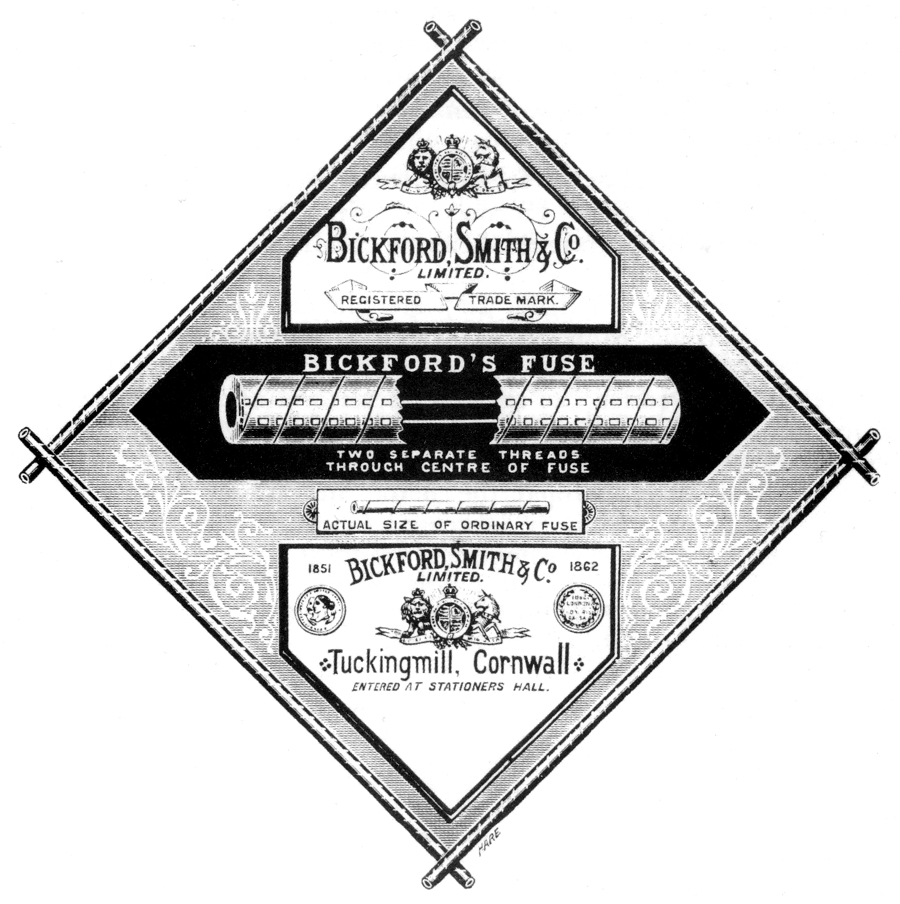Explosives and the Safety Fuse
Devnydhyow-tardha ha'n Lesken Sawder
Blasting in mines was extremely dangerous. Holes were drilled by hand, a charge of gunpowder inserted, tamped, and a fuse lit to fire the hole. Rudimentary powder-filled reed or goose-quill fuses burned unpredictably, resulting in countless accidents to miners involving blinding, loss of fingers, mutilation and death.
Gunpowder and its production
Gunpowder was very expensive, largely because of the monopoly on saltpetre. It was made by mixing and grinding charcoal, sulphur and saltpetre together in water powered incorporating mills. The process was complex with many stages, and also extremely dangerous as gunpowder dust could be readily ignited by the smallest spark.
Gunpowder was imported into Cornwall until 1808 when the first Cornish gunpowder factory opened at Cosawes Wood, Perranarworthal, about 5 miles from Falmouth. The site at Cosawes and at other works – such as the one at nearby Kennall Vale which followed in 1813 – were chosen for their seclusion in wooded river valleys. This ensured both the availability of water power and the relative safety of nearby settlements, shielded as they were by the trees. These also served to shield the process buildings and storage magazines from one another, should an explosion take place. The roofs of the buildings were also designed to blow off relatively harmlessly in the event of a detonation.
The adoption of gunpowder for mine blasting in Cornwall in1689 represented a great technological breakthrough. By 1836 the consumption of this was considerable with 30 tonnes being used in Cornish mines. The first practical high-explosive ever fired in a mine in Cornwall was that at the Restormel Iron Mine (managed by John Taylor) at Lostwithiel in 1846. By the 1870s high explosives were starting to come into wider use being more efficient than the relatively slow burning gunpowder.
Dynamite: a high-explosive
In 1866, Alfred Nobel (1833-96) invented dynamite. This nitroglycerine-based explosive reached Britain the following year and Cornwall soon after. The principal Cornish gunpowder manufacturer, Shilson, set up the National Explosives Company in 1888.
The first factory was built amidst the protective sand dunes of Hayle Towans and soon became one of the leading manufactories in Britain. In 1889 the British & Colonial Explosives Company was formed and the site chosen for the new factory was a hectare of remote old mining ground at St George’s Common on the cliffs west of Perranporth. Extensive structures survive, both at Hayle and at Perranporth.
The safety fuse
By cutting the required length, the burn time of the fuse could be accurately predicted – saving countless lives… and fingers.
In 1830 William Bickford, a currier from the Stannary town of Ashburton in Devon, devised a way of making blasting safer while observing the activities of a rope maker local to his business in Tuckingmill, near Camborne. He noted the means by which individual strands of hemp were woven to make the finished ropes and conceived of how this could be adapted to aid blasting.
How Bickford’s safety fuse worked:
A stream of gunpowder was inserted into the core of twisted jute yarns, which were then bound with twine and sealed with a waterproof varnish of tar. Originally known as ‘safety rods’, the fuses burned, without extinguishing, at a consistent 30 seconds per foot – so by cutting the required length, the time it would take the fuse to burn could be accurately predicted.
A good idea travels far
Bickford obtained his patent in September 1831. The production of the safety fuse in Cornwall increased dramatically as more mines adopted it when blasting underground. The Cornish fuse, made not only by the Bickfords but also by other manufacturers such as Bennetts of Roskear (1870) and Tangyes in Redruth (1886), was sent to mining fields throughout the world.
The Bickford fuse dominated, however, and they soon set up works in America (1837), Germany (1844) and a subsidiary company in Spain (1860). Production further spread with factories in Austria, Australia and Hungary. A century after its invention, the company was manufacturing 160,000km of safety fuse a year.
